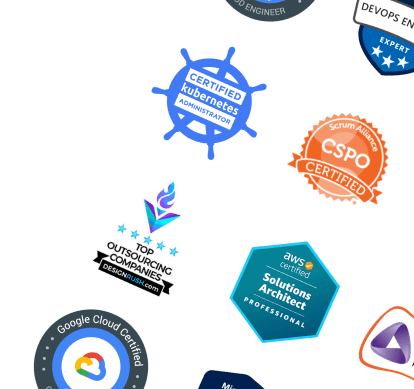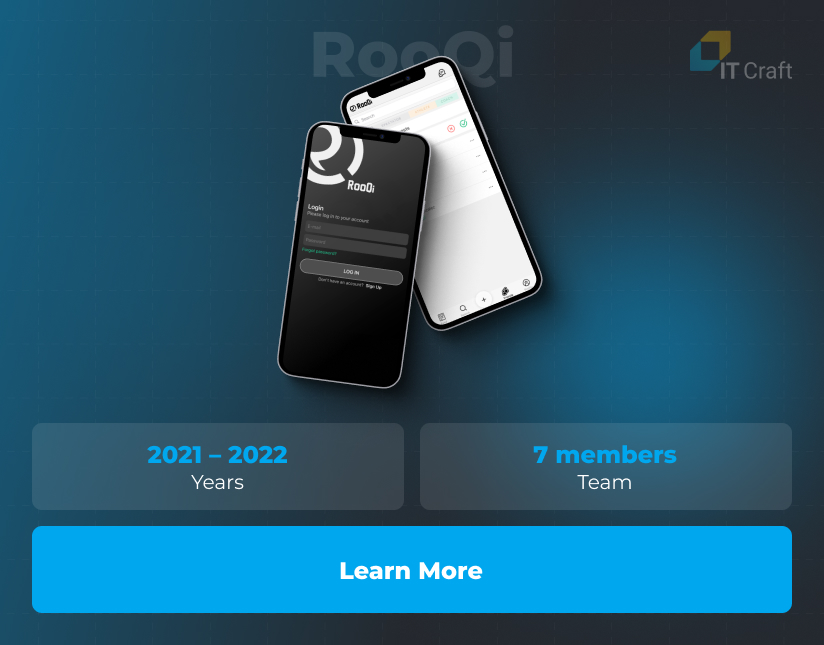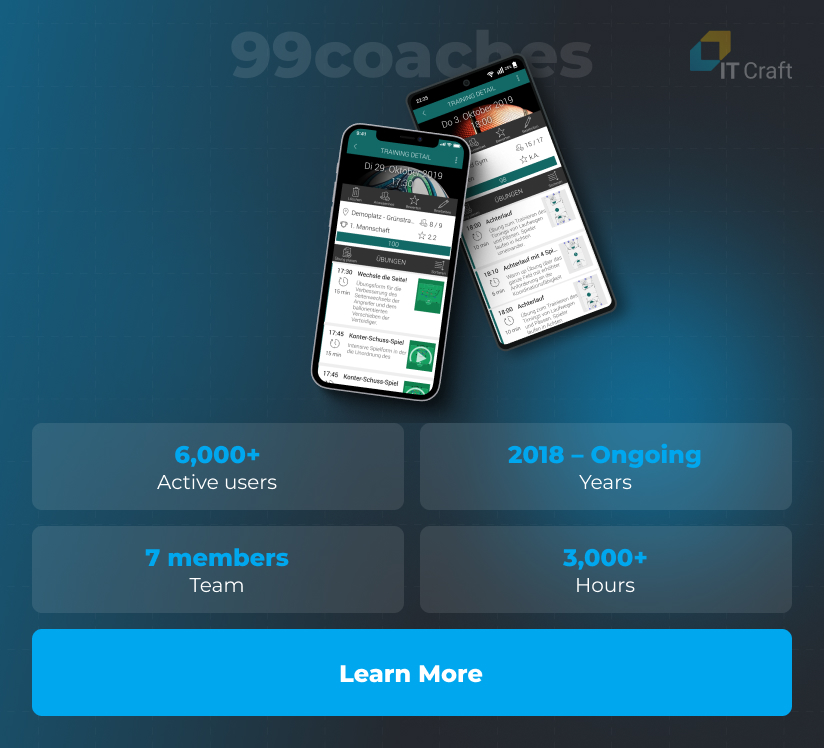How much does it cost to develop a mobile app in 2024?
From a development company’s perspective, the costs of mobile app development based on the average Central and Eastern European hourly rate ($50) range, as follows:
How much does it cost to develop a mobile app in 2024?
From a development company’s perspective, the costs of mobile app development based on the average Central and Eastern European hourly rate ($50) range, as follows:

Why the wide range? As with most things, app development costs depend on what you want.
The cost of creating an app depends on the following factors:
Check out Greg Raiz, a successful angel investor, mentor, and recovering entrepreneur, briefly discussing the basic factors of development price formation:

Or, better, read about the pricing factors in more detail below.
Budget templates and estimate examples are included.
Let’s initiate project discovery and turn its results into a fixed-price agreement.
Discuss details
Let’s focus on statistics related to app development costs and budgeting. Those help us detect market trends and interests.
Key highlights of the market state and trends include:
The two key criteria determining average app development costs are the total number of hours needed to launch an app multiplied by the hourly rate developers charge for their services. As effort and time increase, so do costs.
How much does an app cost to develop? Here is the formula:

The scope of work depends on the complexity of project requirements:
A service provider’s type, region, and expertise level determine average app development costs. North American companies are 2 – 3 times more expensive than Central and Eastern European companies and 2 – 5 times more expensive than Asian.

Let’s analyze the details.
App development costs based on complexity fall into three main categories:

A basic app usually has five to eight screens. It can neither exchange nor synchronize data with a database. It means no data analysis.
Basic apps provide some static data, such as business cards. They enable making one or two very easy actions, such as choosing an item and adding it to a user profile, list, etc., but cannot change item parameters.
Examples: shopping list app, reminder app.
Costs of developing an app of average complexity tend to fall within the price range of most businesses.
These apps can have several functions, which can be quite complex. For example, an online store app can have 10+ screens, integration with the company’s website, and payment systems.
Shipment options and rating features are also possible.
Examples: order management app (without integrations), promotional app.
Complex mobile apps top the list in terms of app development costs. A complex app could include:
…and more.
Examples: video streaming app, marketplace app, social networking app.
App type determines feature list and complexity levels. Knowing the app type lets the team put together project requirements quickly and estimate cost to build an app efficiently. Here is a list of the least to most labor-intensive types:

When checking out development costs, you will see smartphone app development costs increase as you go from East to West, except for Australia, which is also expensive.
The US, Canada, Australia, and Western European countries have the highest developer rates.

So, how much does an app cost to develop in different regions? Based on geographical region, they look the following way:

An important note here: app development costs also fluctuate within each region depending on a company’s expertise.
A company with a solid, proven portfolio, 10+ years in the market, and an office in the USA has a higher hourly rate than a younger, less-experienced company with a small portfolio and no office in the US/EU/Australia.
Organizations envisaging a mobile app project can choose between:
Each option has benefits and drawbacks.
The direct and indirect costs of developing a mobile app are the highest with an in-house team. However, the organization gains improved project control and retains project knowledge.
Freelancers are the least expensive option for hiring. They strive to complete the work fast and with high quality. Still, scaling can be difficult. Also, freelancers might not be interested in occasional maintenance tasks, which can extend costs of source code maintenance.
An outsourcing team takes a middle position. The hiring organization enjoys a transparent cost structure and improved software support, while the vendor is responsible for team management. However, it must hire the best available team to evade potential pitfalls.

The three main approaches to mobile apps include:

The native approach refers to using platform-specific programming languages to deliver mobile apps. Software developers launch two separate code bases for each platform plus a web solution if required.
The native approach is the most expensive but guarantees the best performance.
Cross-platform/hybrid means software developers use special frameworks (React Native, Flutter, .NET, etc.) to create a shared codebase, which frameworks translate into native code.
The cross-platform approach enables the team to save up to 60% of mobile app development costs. However, specific limitations in performance and access to device features apply.
Progressive web app technology lets businesses convert a web solution into a mobile app within the least possible time and budget. Still, its performance optimization capabilities and features are limited.
Share your concerns with our leading experts in mobile app development. We can help you make a solid estimate.
Contact us
Determining the price range is only a part of the challenge. Proper cost allocation during each development stage plays a vital role.
As with all projects, the development team does more than develop code to create an app and successfully launch it.

Let’s check mobile app development costs across the life cycle:

Discovery and planning is the first stage of app development, which is crucial for success. The team discusses business goals, specifics, and limitations with the client. It also conducts a study if the answers are general.
The team uses the collected insights to compose a list of requirements, prepare a plan, and make estimates based on them. It coordinates all deliverables of this stage with the client.
Cost and timeline of discovery and planning stage:

The team works on the future app’s user flow and visual elements. It prepares wireframes and forms a map of screens to present logical connections between screens.
After the client approves the map, designers work on the UI. Project designers might need a user study and several improvement iterations to make a straightforward design that end users will love.
Cost and timeline of UX/UI design stage:

The back end is the project part where calculations, data storage, and processing occur.
The optimized back-end part is critical for open and immediate client-server interaction. As a result, the success of the server part and server logic relies heavily on developers’ skills and experience as well as their understanding of the client’s processes.
Admin Panel is necessary for efficient system control, ensuring the business can easily track vital app parameters and manage mobile users.

The team develops the functionality of mobile apps using the envisaged approach.
It delivers a separate app for each mobile platform using the native approach. The same codebase is adapted to the platforms using a cross-platform approach.

QA and testing must be carried out as part of each Sprint to ensure high-quality new deliveries.
QAs determine if there is full compliance with both concept and functional requirements.
The launch deadline depends on detecting bugs and resolving issues quickly. QA engineers deploy test automation at scale on large projects. Automated tests decrease the costs of specific checks, e.g., regression, scalability, load, and more.

The review process takes time on the store side.
To pass the review fast, the team must prepare a package that includes:
The team must also deploy the app on live servers when required and make them available to end users.

Project management is not a separate stage of app development per se. Instead, they distribute their efforts throughout the entire lifecycle.
The project manager’s role is important for the team’s efficiency and productivity. Project managers work on project planning and team coordination, ensuring a shared vision among all project participants, meeting deadlines, and more.

Budgeting clarifies where possible risks and optimization opportunities lie when you outsource app development.
For instance, the IT Craft team presents an estimate during the initial project stages. It includes a detailed feature list and a work-base statement containing all project-related activities.
Our experts use a budget template to divide a project into milestones, which are used in turn for each sprint planning.
Each Sprint starts with a separate estimate and ends with a report. The numbers serve for progress tracking and adjustments if required.
An budget estimate template looks the following way:

When answering the question “How much does it cost to start an app?” remember that app expenses do not end with its launch. Add updates, scaling, indirect marketing costs, etc., to your budget plan.
Even though it is difficult to determine the exact cost of a mobile app after the product release, let’s analyze the main cost-generative factors and their impact.

A team must ensure the app is available on all user devices. It must also monitor app servers to avoid any downtime.
App maintenance will cost its owner 15% – 20% of initial app development costs per year.
Hence, total costs will look the following way:

Third-party solutions significantly decrease development time. Yet, they become regular expenses once an app is launched. These expenses increase with user base growth: payment plans are segmented based on certain usage criteria.
Both mobile OSs and third-party services are constantly updated. In some cases, apps can stop working after an update.
Unfortunately, no one can forecast how long app updates will take or which apps will stop working. Still, the team must fix the problem as soon as possible.
Third-party services get deprecated, reach the end of life, or shut down. Service providers often offer free migration tools to help mitigate migration-related risks and losses. Yet, you need someone to help you transmit your environment to a new provider.
As an app owner, you must be aware of scalability. If your app gets more hits than expected, you must prepare to scale up server infrastructure. The opposite is also true: you must downscale to avoid unnecessary payments when user load decreases.
Due to fierce competition for user time, user acquisition and retention costs can easily exceed development costs three times and higher. A business must be clear of project goals and ready to adapt different strategies to meet user needs.
Risks are that total app development costs can change considerably from the initially agreed amount.
Still, businesses can optimize costs to develop an app by:
Outlining the budget range during the initial call is essential. It lets the team prioritize the most important features. The team suggests a path that balances scope and deliverables and abides by it.
Programming outsourcing is a winning strategy when the client and the development team invest in project success. To keep pace with the project timeline, a product owner must be available to answer any clarifying questions the team asks.
Without specific domain knowledge, e.g., app development for startups, developers might be too optimistic about their estimates.
A client who wants a project launched fast can urge them to quickly provide an estimate (i.e., guesstimate). Still, it is possible when developers know the industry and notice extensive elements affecting the total project scope.
Businesses must innovate to beat the competition. Yet, dealing with novelty may take longer than anticipated. Developers might need to design and test specific algorithms.
Project discovery lets the team evaluate idea feasibility without spending too much and determine an optimum path.
Knowing project costs ahead helps startups with budget planning. However, it challenges complex projects as all changes are discussed separately, taking time and resources.
Time and material work for projects with flexible requirements, helping anticipate and overcome long-term challenges. Still, it may create unnecessary complexity on simple projects, increasing the cost of app development.
Send us your requirements. We will help you design a path optimizing custom app development costs.
When looking for app developers, ensure the team is flexible, open, and ready to discuss issues with you.
When evaluating the future project team, examine the following points:
Make a list of requirements for your future development team. Consider your priorities (cost of app development? code quality? timeline? etc.) Go through Clutch reviews to check how well the team coped with priorities that were the same or similar to yours, e.g., Android app development.
Check the company’s reviews and ratings provided by its current and former employees. You need specialists’ full focus on your project, not finding a better working place.
For instance, many of IT Craft’s leading specialists have been working for 5+ years in the company.
Keep an eye on the team’s actions during and after calls. What questions do they ask? Are they transparent? Do they create a sense of urgency?
Ensure developers understand you and your concerns. They are on the same page regarding project goals and limits.
An unreasonably low quote signalizes hidden costs. The project will cost you 2-3 higher because of extra charges. Or because the company’s developers lack expertise. You do not need either.
It is safe to start with the discovery stage or a pilot task.
Both parties can evaluate each other and decide on the best cooperation terms. As the client, you determine whether the development team can handle it. The team better understands you and your project.
Risks occur when the development team comes in with an unrealistic or wrong project scenario. The team may lack experience or want a client to sign on the bottom line.
Risks of unnecessary app development costs might remain unnoticed at the project start. They will accelerate like an avalanche, with compounding costs spiraling out of control.
A disreputable company provides a below-cost estimate just to get the client’s signature on the contract. Yet, terms are undetailed, intending to cover expenses with hidden costs.
A nice, intuitive, clear design takes time and expertise. If the team does not understand how the app will work, if it lacks expertise in a user study and UX implementation, users will get no benefits. They will close the app and virtually walk away.
Overengineering causes creep in development and maintenance costs. Underengineering results in increased update costs or even blocked feature expansion. When an app rests on an outdated tech stack, its lifecycle is short. You should avoid all three scenarios.
Source code quality affects app performance and maintenance costs. Updates become expensive when the development team takes too much time figuring out why new code does not work or checking whether any or all functionality remains available after an update.
The development team may be required to cut corners to deliver as fast as possible, ensuring business value. Yet, the team must address technical debt after the launch. Otherwise, it will block project success in the long run, challenging app maintenance and expansion.
It depends on your goals, vision, and requirements. Upon Discovery Stage, a precise estimate is possible — check IT Craft’s Startup Kit for more details.
Here are two specific examples of two MVP apps to help you make a bigger picture:
RooQi creates recruitment opportunities by connecting young athletes and coaches directly with each other. Athletes can showcase their talents, follow teams, and message coaches. Coaches can search and follow rising stars.
The client partnered with IT Craft to acquire needed technical expertise for building an MVP iOS app quickly and efficiently.

Key Activities:
99coaches enables football and basketball coaches to plan and manage training sessions effectively. They can add exercises from the library or create their own. Then, they manage details such as order, time, set per exercise, etc.

Scope and project activities activities:
Selected cross-platform approach ensured:
Benefits for users:
Coaches track training attendance and team progress. It is possible to manage several teams from one profile. Constant app synchronization ensures instant availability of all information.
The offline mode lets coaches reach necessary information even without stable internet connection.
Here is a little insight into the timeline needed to deliver app functionality. It helps you make a bigger picture of how much a single feature might cost.
Below is an approximate app development cost breakdown for certain app features:

The estimated scope encompasses basic functionality. The average cost of app development increases when custom features are added.
There is more for you. Estimates for three types of apps available give you a clearer understanding of typical project costs.
Click on the link below, and the estimate will open in a new tab as a PDF file:
Do you want to try estimating costs on your own?
Then, your choice is the app cost calculator.
How much does it cost to build a mobile app? Check it out. Pick up the options you envision, simple or complex.
The calculator guides you through the essentials of the estimation process within ten steps.
It takes only 5 – 10 minutes of your time.

You get:
All information is available as a PDF and emailed to your address. Nothing gets lost.
It is hard to guestimate the costs of your mobile app without actual app requirements.
Depending on project complexity, the following costs are needed to develop and launch basic app functionality:
Basic apps: $10,000 – $16,500
Average-complexity apps: $40,000 – $71,500
Complex mobile apps: $75,000 – $220,000
On average, app maintenance costs make up 15% – 20% of total app development costs per year. For example, if your app development costs you $50,000, maintenance costs will range between $7,500 and $10,000.
Unfortunately, there is no direct answer to this question. Any app development price range is based on average functionality. It may or may not align with your app.
Still, if you want an answer for your specific case, let’s start a discovery stage. Our team examines your idea or requirements and prepares a solid estimate.
Depending on project size and complexity: